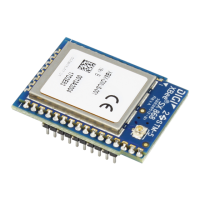Networking methods Data transmission and routing
XBee® SX 868 RF Module User Guide
89
In order to avoid RF packet collisions, the network inserts a random delay before each router relays
the broadcast message. You can change this random delay time with the NN parameter.
Sending frequent broadcast transmissions can quickly reduce the available network bandwidth. Use
broadcast transmissions sparingly.
The broadcast address is a 64 bit address with the lowest 16 bits set to 1. The upper bits are set to 0.
To send a broadcast transmission:
n
Set DH to 0.
n
Set DL to 0xFFFF.
In API operating mode, this sets the destination address to 0x000000000000FFFF.
Routing
Devices within a mesh network determine reliable routes using a routing algorithm and table. The
routing algorithm uses a reactive method derived from Ad-hoc On-demand Distance Vector (AODV).
The device uses an associative routing table to map a destination node address with its next hop. By
sending a message to the next hop address, the message reaches its destination or is forwarded to an
intermediate router which routes the message on to its destination.
The device broadcasts a message with a broadcast address to all neighbors. All routers receiving the
message rebroadcast the message MT+1 times and eventually the message reaches all corners of the
network. Packet tracking prevents a node from resending a broadcast message more than MT+1
times.
Route discovery
Route discovery is a process that occurs when:
1. The source node does not have a route to the requested destination.
2. A route fails. This happens when the source node uses up its network retries without receiving
an ACK.
Route discovery begins by the source node broadcasting a route request (RREQ). We call any router
that receives the RREQ and is not the ultimate destination, an intermediate node.
Intermediate nodes may either drop or forward a RREQ, depending on whether the new RREQ has a
better route back to the source node. If so, the node saves, updates and broadcasts the RREQ.
When the ultimate destination receives the RREQ, it unicasts a route reply (RREP) back to the source
node along the path of the RREQ. It does this regardless of route quality and regardless of how many
times it has seen an RREQ before.
This allows the source node to receive multiple route replies. The source node selects the route with
the best round trip route quality, which it uses for the queued packet and for subsequent packets with
the same destination address.
DigiMesh throughput
Throughput in a DigiMesh network can vary due to a number of variables, including:
n
The number of hops.
n
If you enable or disable encryption.
n
Sleeping end devices.
n
Failures and route discoveries.

